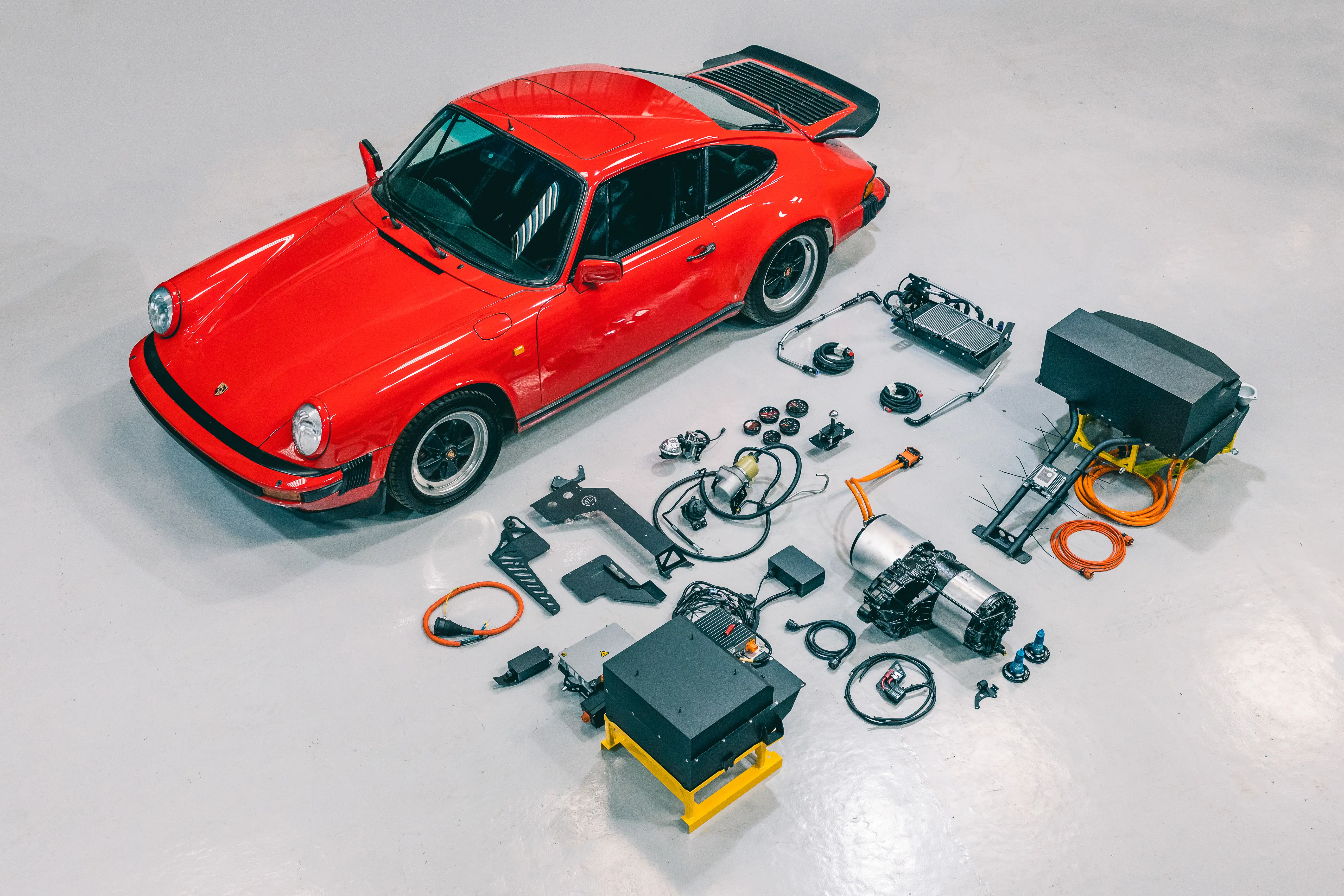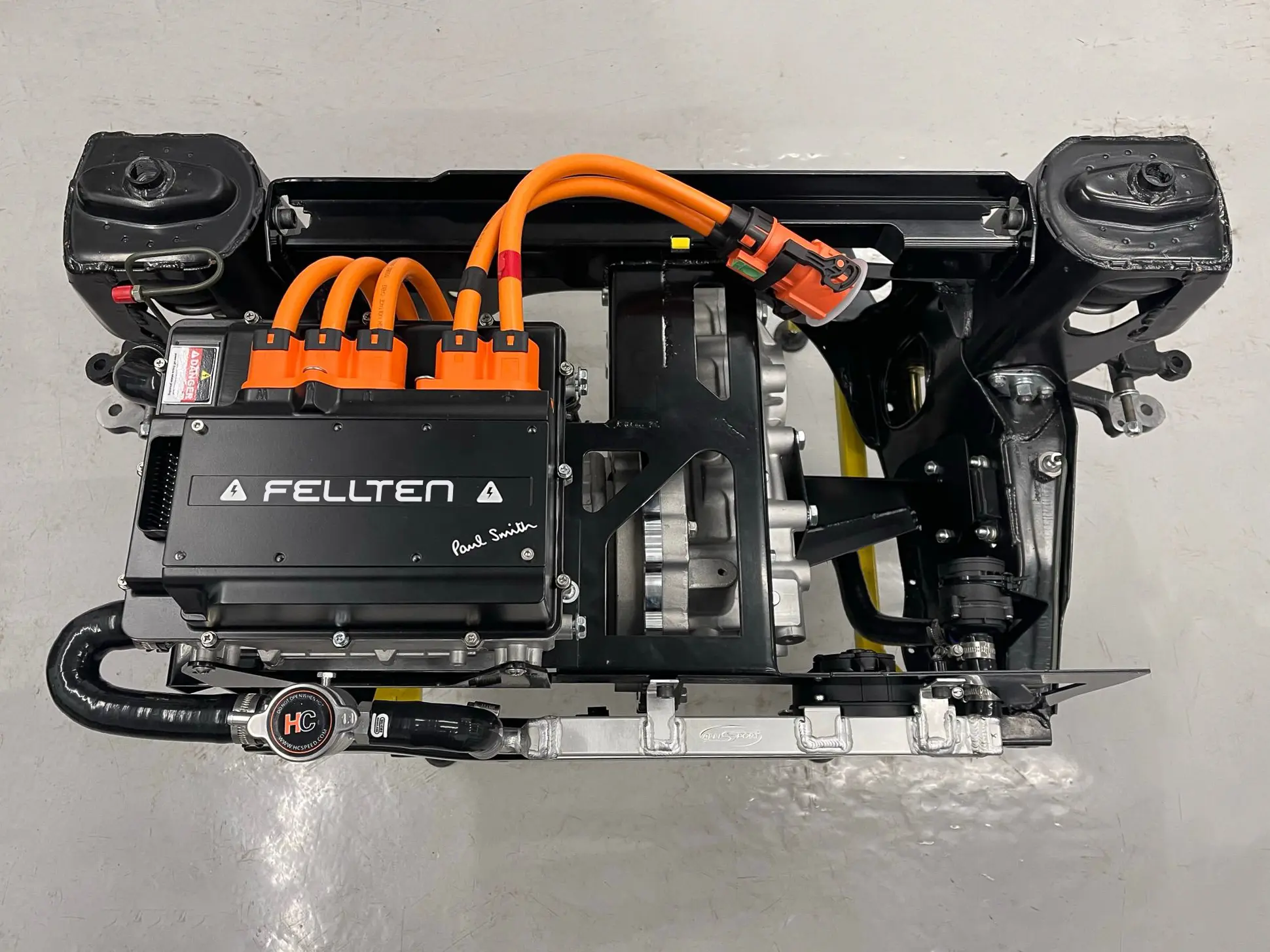Staying Positive: “Just remove the engine and gearbox” to make a classic electric vehicle
28 March 2023
There are three main reasons why you wouldn’t convert a classic car to battery power.
In Part 2 of Staying Positive, Jérôme André, editor of the EV Builders’ Guide, identified cost as a major factor.
We’ll cover the other two matters, those of originality and taste at a later date; what the DVLA considers ‘original’ has long been a bone of contention for historic vehicle campaigners, and certain electric vehicle conversions have, in the past, fallen foul of Swansea’s arbiters.
Thanks to his close ties to the electric vehicle conversion industry, Jérôme is convinced that, within the next five years, fitting batteries to a classic will be far more affordable than it is now – as more and more manufacturers are building ‘plug-and-play’ drop-in kits to electrify historics.

We’re seeing more model-specific one box solutions, as the industry likes to call them, arising from the UK, for cars such as the Porsche 911, Land Rover Defender, and Mini. Bristol-based Fellten offers kits for all three cars; London Electric Cars has converted the latter two, and Swindon Powertrain (SWIND) offers a drop in battery and subframe for the Issigonis classic.
Let’s not forget RBW, either: while its current models are based around the (Heritage bodyshelled) MGB, MGB GT, and Jaguar E-type, founder Peter Swain has said that his firm’s power pack could be made to fit under any rear-wheel drive classic.
‘Based on the years of learning and architecture, the system also supports vehicle conversions for many Classic or even high-end modern vehicles,’ the firm confirmed. Its Up-Cycling Division was opened last year to cater for such work.
Peter added: ‘I do not know how you can convert vehicles with no safety strategy, weight walk and test procedure in place (or to put it another way, you can test the car Mr Client when you get it back, let us know how it goes?) Very dangerous. For the conversion market to be taken seriously I believe we need far more governance and regulation!’
As we’ll see, Jérôme also sees the future of electric car conversion in the hands of trained specialists fitting pre-made kits – but Peter’s comments also rang true with where the industry is thought to be heading – and that industry is growing, rapidly.
Of that future industry, Jérôme said: ‘Companies are coming up with solutions that are already built in factories […] producing dozens [if not] hundreds of battery packs and complete solutions to drop in vehicles.
There are a couple of companies producing systems that will go straight into your Defender [for example] where you, in air quotes, “just remove the engine and gearbox” and you bolt in a box with everything in it as far as the battery, the battery, the inverter, everything is built into this box.
Everything is enclosed in this big box, which is the size of a [Ford] Coyote [V8] engine, which is a relatively compact engine. Anything that has a V8 say a Ford Bronco, Mustang, or any muscle car or pickup truck with a V8 engine [is eligible].

These systems are getting closer to £60,000 now and they’re only making 20 this year, but next year they’re heading for 50, the next year 100 with orders already from specialists.
The industry is expanding rapidly; two or three years ago it was just people doing this in their garages at home thinking they could make a business of it.’
One area that has upset traditionalists is the converting of already good or mint cars – as restoration adds extra costs and delays classics returning to the road. Nevertheless, it can be done: firms like Lunaz will take a basket case in one end and hand over a fully restored vehicle at the other, but, as you’d imagine, it isn’t cheap.
Even with just the engine and gearbox removed, owners can keep the original units to revert back to standard or, as we found in Part 1 of Staying Positive, sold or donated on to keep other examples of the marque running as their makers intended.
Jérôme continued: ‘The industry has understood the need to start with very good cars or fully restored cars, already repainted and so on.
In the UK the whole conversion industry is working with the DVLA to make sure they don’t drill they don’t weld, they don’t cut or weld anything to [the shell] or to the firewalls. It’s understood that there needs to be a standard, they want to retain their registration and it’s much easier for insurance purposes if you don’t touch anything.
The new companies bring built in systems are plug and play, all the wires and cables are cut to the right length, they clip in, the cooling system is the right length with 90 degree angles and elbows. The reason that converting a vehicle is still relatively expensive is that research and development [costs, that need to be passed on to customers] are still significant.
[In the future], independent specialists [will] install the kits. They need to scale and cannot cope with retail customers, they need to sell those units, but they’re shipping kits all over the world.’
Classics, in Jérôme’s opinion, have a crucial role to play, for their cultural visibility makes the idea of mass converting younger, mainstream cars more palatable. As more conversion kits are made, more cars can be altered to use battery power, driving down the cost as they go.
We won’t have to wait that long, either. ‘In two to three years there will be solutions available for under £20,000, there will be more scaling, more competition and more mainstream systems; I’m pretty sure it will be a mainstream way to convert a car,’ Jérôme predicted.
‘We have plenty of electric cars but there are millions of cars on the road already that people want to replace, but there’s nothing wrong with the car apart from say, its engine is about to die or the fact it cannot go into London [without paying].
The bodyshells and electronics are [most likely] fine, but [fitting batteries and a motor] would be a very efficient way to convert existing cars [as they have already been built].
I’ve always been passionate about converting classic cars but the real aim for converting is to convert masses of cars – like Golfs, Astras and Fiestas.
What we’ve gathered in the industry is the classic car market is very important for marketing purposes, to share the message.
There is a five to eight year window where we will be able to convert more regular cars – SUVs, hatches and small vans, but within five to ten years we won’t be converting regular cars because they’ll have been scrapped even if they’ve been converted, it will be cheaper to make electric cars from the get-go, and the [conversion] industry will go back to converting classic cars because they will be the only cars worth converting [still extant] to keep on the road.’
